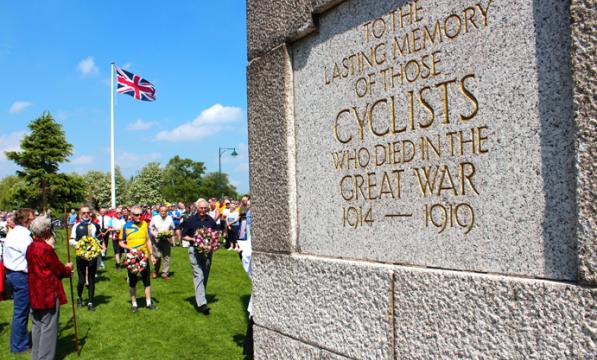Hundreds attend Meriden centennial service commemorating sacrifice of WW1 cyclists

Four hundred cyclists attended the event organised by CTC.
Held each year since 1921, when the monolith was erected, this year's turn-out reinforced the fact that though 100 years have passed, we have not forgotten.
Riders with their bicycles began to arrive from 10 am. Their cycling jerseys testified that riders had come from near and far - from Gloucestershire, Cheltenham, Tamworth and Evesham, to name only a few places.
We were very pleased to have a great turn-out on the day. It was fantastic to see cyclists come from far and wide to mark this occasion and pay their respect to cyclists who fought and died in the war."
John Bennett
Event Organiser
Amongst the crowd was member Barrie Hodges from Nottinghamshire, who has been attending the cyclists’ service more or less every year since 1972. Having served in the army himself, Barrie thinks it is important to pay his respects.
24 year-old cyclist, Ed Holt from London, also journeyed up to Meriden to take part in the organised rides and Sunday’s service. Ed's blog about the weekend can be found here.
The ceremony was commenced by a brass band and the Bishop of Warwick led the ceremony to mark the 100 years since the start of the Great War. The Bishop also unveiled a new plaque dedicated to cyclists killed in action since 1945.
The stunning summer weather made Saturday’s 30 mile social ride a fantastic day out, and it was heart-warming to see so many turn up to pay their respects at the Sunday service."
Ed Holt
Cyclist
When the memorial was unveiled in 1921 by the Cyclists' Touring Club (CTC), the service attracted numbers in excess of 10,000 cyclists.
The very first British and Commonwealth solder killed in the First World War was Private John Parr, a reconnaissance cyclist, who lost his life on 21 August 1914. Some cyclists joined the Army Cyclist Corps, which played a key role in reconnaissance and provided vital communications at the Front. Many cyclists also joined up as ordinary soldiers.
The initial idea for the cyclists’ monument came at the end of the War in 1919, when the Cyclists’ Touring Club (CTC) made a huge fundraising effort to get the project off the ground. Senior CTC personalities threw their weight behind the scheme and managed to attract powerful national support: the Lord Chancellor agreed to be the President of the fund and even the Prince of Wales lent a hand by donating a bicycle for auctioning. No other sport has commemorated its fallen participants in such a fashion, showing the unique bond all cyclists continue to share.



